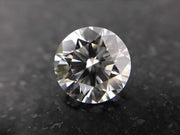Photo: Rich Dieckhoff
, 2021
When you think about being more eco-friendly, you might think about using less single-use plastic or carrying around your own reusable straw and coffee cup. What you might not think about is opting for a sustainable diamond when looking for the perfect piece of jewelry. It’s definitely worth the consideration, though: Sustainable diamonds are better for the environment, much more ethical, and might even save you some money.
As the ever-growing problem of climate change forces us all to focus on being more environmentally-friendly in our everyday lives, sustainable diamonds are becoming an increasingly popular option.
Curious about using one for your engagement ring (or another piece of jewelry)? Jewelers Ryan Shearman of Aether Diamonds, Azra Mehdi of Au Xchange Fine Gold Jewelry, and Khadijah Fulton of White/Space share everything you need to know about sustainable diamonds.
Sustainable Diamonds vs. Natural Diamonds
In general, sustainable lab-grown diamonds are 25 to 40 percent less expensive than natural mined diamonds. “[Lab-grown] and recycled diamonds are significantly lower priced than natural diamonds, for the same or better quality,” Fulton says.
While many mainstream diamond retailers offer ethical diamonds, sustainable diamonds are much better for the earth environmentally since mining diamonds has a huge impact on climate change. “The traditional diamond industry has been disastrous for the planet,” Shearman tells Brides
He explains, “On average, for every one carat that is mined from the ground, up to 250 tons of earth are removed, 127 gallons of freshwater are used, billions of gallons of water are contaminated with acid mine runoff, 143 pounds of air pollution are emitted, and countless gallons of fossil fuels are consumed." These mining practices can have so many negative results, from flooding to drought to deforestation.
On top of that, diamond mining can sometimes be an unethical practice. “The mines are often located in places where the local communities’ needs are marginalized,” Mehdi admits. “Diamond mining has previously been done without regard to the social, environmental, and long-term ecological impact on local communities.”
Types of Sustainable Diamonds
Recycled Diamonds
Recycled diamonds that have been reused, recut, and reset are a very popular form of sustainable diamonds. “Although the original source of the diamonds may be unknown and they may likely have been unsustainably sourced, recycling diamonds prevents continued future harm from unethical or improper diamond mining practices,” Mehdi explains. The advantage of recycled diamonds is that you’re still getting a mined diamond, but because it’s something that’s being repurposed, it’s still considered better for the planet.
Lab-Grown Diamonds
Lab-grown or synthetic diamonds are also considered sustainable and are becoming a more popular option as well. Since these stones are not mined, they’re considered sustainable. Fulton says, “Lab-grown diamonds are real diamonds that have been grown in a lab—essentially, the millions-years long process of heat and pressure involved in creating a natural diamond underground is mimicked in a lab.”
Carbon-Negative Diamonds
There are some companies who get a little more creative, like Shearman's Aether Diamonds, for example. As Shearman explains, the brand actually creates its diamonds, which are the world’s first carbon-negative diamonds and “the only truly sustainable diamonds on the market."
He explains, “By carbon-negative, we mean that we actually remove carbon from the atmosphere and convert it into diamonds, which capture that carbon in crystalline form forever." He goes on to add that their practices remove 20 metric tons of pollution from the atmosphere for every one-carat diamond they make.
Pros and Cons
Pros
The obvious advantage of buying a sustainable diamond is that you’re making the conscious decision to do something to aid in the fight against climate change. As Shearman says, “If every person buying a diamond chose a sustainable one instead of a mined one, we could stop the massive damage done to our planet on an ongoing basis and actually help to reverse it.”
The advantage of opting for a lab-grown or synthetic diamond is that they’re less expensive than traditionally mined diamonds, too. “Lab-grown or synthetic diamonds are not mined, but contain the same physical, chemical, and optical characteristics of mined diamonds,” Mehdi says.
A lab-grown diamond might also look more clear. “The clarity of [lab-grown] diamonds is excellent, so you are able to get a bigger, brighter stone with more fire for a lower price than using a traditionally mined diamond,” says Fulton.
Cons
[...Mehdi] points out that lab-grown diamonds may bring up their own issues. She says there is “the possibility that the manufacturing process for lab-grown diamonds—replicating the high temperature and high-pressure environment under which a diamond is formed—may leave a similar or worse carbon footprint than natural diamond mining.”
Shearman echoes that same concern, saying, “Lab-grown diamonds require two things: carbon as their raw materials and energy to power the reactors. All of the other lab-grown diamonds you’ll find on the market source their carbon from fossil fuels, often obtained through drilling and fracking. The vast majority of other lab-grown diamond suppliers rely on those same fossil fuels to power their reactors, so there’s a huge energy impact to how they’re produced.”
There’s also an unfortunate stigma around lab-grown diamonds, with many people believing they aren’t real diamonds. “In fact, they are visually and chemically identical to diamonds that are mined from the earth,” Shearman says, adding that they are certified the same way mined diamonds are.
Buying Considerations
The most important thing to keep in mind when purchasing a sustainable diamond is whether or not it’s actually sustainable. A lab-grown diamond does not automatically equal a more sustainable diamond. “Look for jewelers that can provide some documentation from the sources of their stones,” Fulton advises. “If they are working with reputable sources, they will be able to provide this to give a more in-depth idea of the process involved in creating their lab-grown diamonds or sourcing their recycled stones.”
She also recommends researching to see if that diamond source is invested in reducing their carbon footprint. “The amount of energy involved in creating a lab-grown diamond is significant, so make sure to go with sources that are actively working to make their manufacturing processes as energy-efficient as possible,” Fulton says.
Shearman also says you shouldn’t feel afraid to ask questions about what a diamond retailer's production process looks like. “Ask, ‘What kind of energy powers your reactors?’ and ‘Where does the carbon for your diamonds come from?’” he says. “Odds are they’ll have a tough time answering those questions in detail if they have practices that don’t take the environment into account.”
As always, be sure to work with a jeweler you trust. “Trust your own judgment and intuition,” Shearman says. “This is a big purchase, and you should be confident in the information you have and how you feel about it.”




